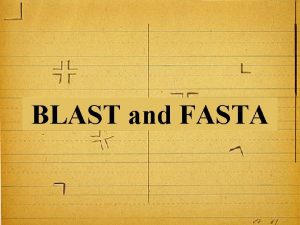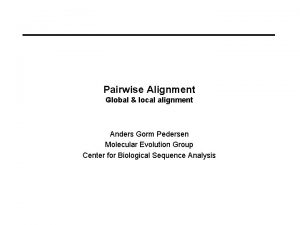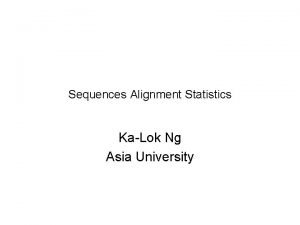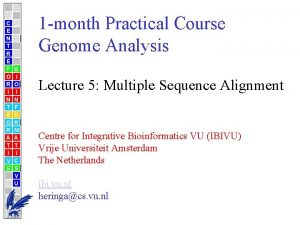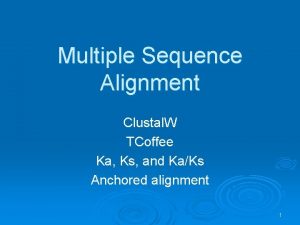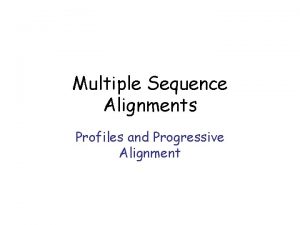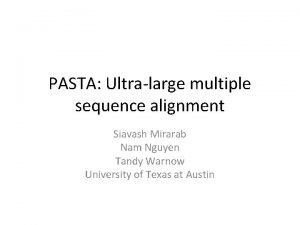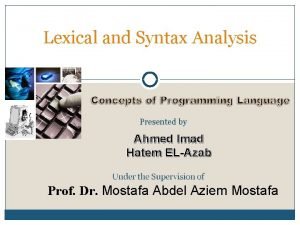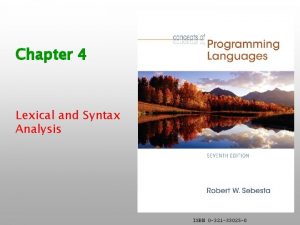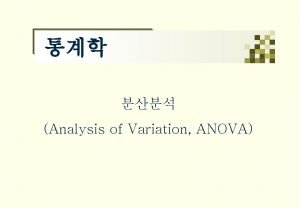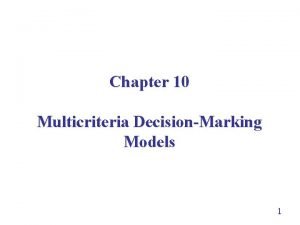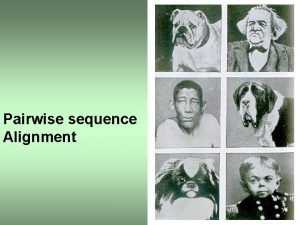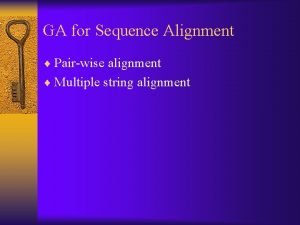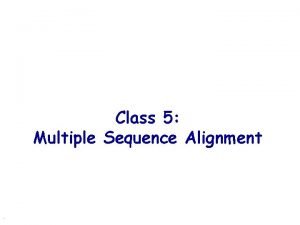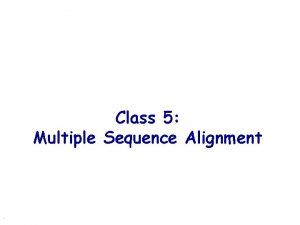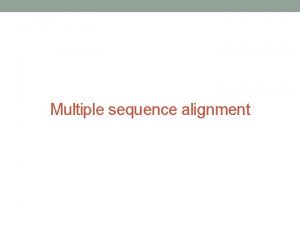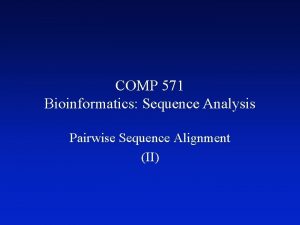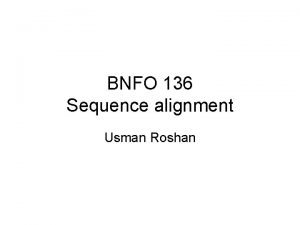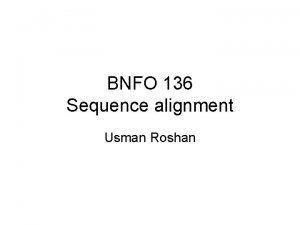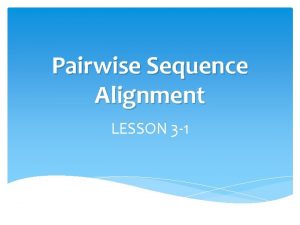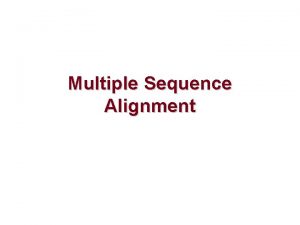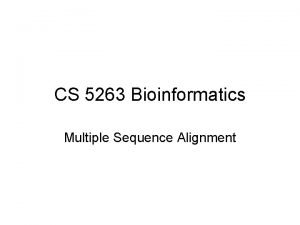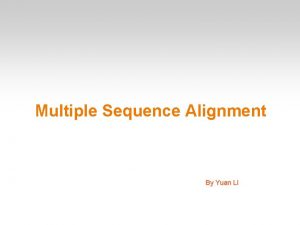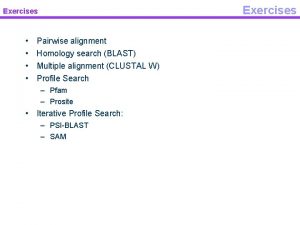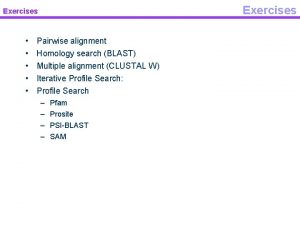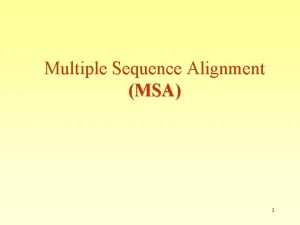Multiple Sequence Alignment Multiple Alignment versus Pairwise Alignment






















- Slides: 22

Multiple Sequence Alignment

Multiple Alignment versus Pairwise Alignment • Up until now we have only tried to align two sequences. • What about more than two? And what for? • A faint similarity between two sequences becomes significant if present in many • Multiple alignments can reveal subtle similarities that pairwise alignments do not reveal

Generalizing the Notion of Pairwise Alignment • Alignment of 2 sequences is represented as a 2 -row matrix • In a similar way, we represent alignment of 3 sequences as a 3 -row matrix A T - G C G A _ C G T - A A T C A C - A • Score: more conserved columns, better alignment

Aligning Three Sequences • Same strategy as aligning two sequences • Use a 3 -D “Manhattan Cube”, with each axis representing a sequence to align • For global alignments, go from source to sink source sink

2 -D cell versus 2 -D Alignment Cell In 2 -D, 3 edges in each unit square In 3 -D, 7 edges in each unit cube

Architecture of 3 -D Alignment Cell (i-1, j, k-1) (i-1, j-1, k-1) (i-1, j, k) (i-1, j-1, k) (i, j, k-1) (i, j-1, k) (i, j, k)

Multiple Alignment: Dynamic Programming • si, j, k = max si-1, j-1, k-1 + (vi, wj, uk) si-1, j-1, k + (vi, wj, _ ) si-1, j, k-1 + (vi, _, uk) si, j-1, k-1 + (_, wj, uk) si-1, j, k + (vi, _ , _) si, j-1, k + (_, wj, _) si, j, k-1 + (_, _, uk) cube diagonal: no indels face diagonal: one indel edge diagonal: two indels • (x, y, z) is an entry in the 3 -D scoring matrix

Multiple Alignment: Running Time • For 3 sequences of length n, the run time is 7 n 3; O(n 3) • For k sequences, build a k-dimensional Manhattan, with run time (2 k-1)(nk); O(2 knk) • Conclusion: dynamic programming approach for alignment between two sequences is easily extended to k sequences but it is impractical due to exponential running time

Practically speaking • Multiple alignment is a hard problem • Yet, it is of extreme practical importance – Comparing several species is a very common task – Doing this for the entire genome is an increasingly common demand! • Several heuristic-based algorithms have been developed that employ greedy, divide-andconquer, dynamic programming approaches in various combinations • The algorithms we will see today are actually used by current multiple aligners

Multiple Alignment Induces Pairwise Alignments Every multiple alignment induces pairwise alignments x: y: z: AC-GCGG-C AC-GC-GAG GCCGC-GAG Induces: x: ACGCGG-C; y: ACGC-GAC; x: AC-GCGG-C; z: GCCGC-GAG; y: AC-GCGAG z: GCCGCGAG

Reverse Problem: Constructing Multiple Alignment from Pairwise Alignments Given 3 arbitrary pairwise alignments: x: ACGCTGG-C; y: ACGC--GAC; x: AC-GCTGG-C; z: GCCGCA-GAG; y: AC-GC-GAG z: GCCGCAGAG can we construct a multiple alignment that induces them?

Reverse Problem: Constructing Multiple Alignment from Pairwise Alignments Given 3 arbitrary pairwise alignments: x: ACGCTGG-C; y: ACGC--GAC; x: AC-GCTGG-C; z: GCCGCA-GAG; y: AC-GC-GAG z: GCCGCAGAG can we construct a multiple alignment that induces them? NOT ALWAYS Pairwise alignments may be inconsistent

Multiple Alignment: Greedy Approach • Choose most similar pair of strings and combine into a profile , thereby reducing alignment of k sequences to an alignment of of k-1 sequences/profiles. Repeat • This is a heuristic greedy method k u 1= ACGTACGT… u 1= ACg/t. TACg/c. T… u 2 = TTAATTAATTAA… u 3 = ACTACT… … … uk = CCGGCCGGCCGG k-1

Progressive Alignment • Progressive alignment is a variation of greedy algorithm with a somewhat more intelligent strategy for choosing the order of alignments.

Clustal • Popular multiple alignment tool today • Uses “progressive alignment” • Three-step process 1. ) Construct pairwise alignments 2. ) Build Guide Tree 3. ) Progressive Alignment guided by the tree

Step 1: Pairwise Alignment • Aligns each sequence again each other giving a similarity matrix • Similarity = exact matches / sequence length (percent identity) v 1 v 2 v 3 v 4. 17. 87. 28. 59. 33. 62 -

Step 2: Guide Tree • Create Guide Tree using the similarity matrix • Clustal. W uses the “neighbor-joining method” • Guide tree roughly reflects evolutionary relations

Step 2: Guide Tree (cont’d) v 1 v 2 v 3 v 4 v 1 v 3 v 4 v 2 v 1 v 2 v 3 v 4. 17. 87. 28. 59. 33. 62 Calculate: v 1, 3, 4 v 1, 2, 3, 4 = alignment (v 1, v 3) = alignment((v 1, 3), v 4) = alignment((v 1, 3, 4), v 2)

Step 3: Progressive Alignment • Start by aligning the two most similar sequences • Following the guide tree, add in the next sequences, aligning to the existing alignment • An alignment is stored as a “consensus sequence”, to be aligned with other sequences or alignments later • Consensus sequence: Residue a if 75% of aligned sequences have an a at that position. Otherwise “X”.

Evaluation • Evaluating alignment programs is very difficult • What is a benchmark here ? • We haven’t witnessed the process of evolution, so we cannot say for certain what the true alignment of “extant” sequences should be • One approach: “simulate” evolution

Simulating evolution • Generate a random sequence and introduce realistic evolutionary changes to it, along branches of an assumed phylogeny • Substitutions, insertions, deletions, insertion & deletion rates, duplications, introduction of repeat elements, etc.

Evaluating alignment • Once simulation done, take all the sequences at the leaf nodes of the phylogeny (started with root) • Align these sequences using software • Compare computed alignment and known (“true”) alignment – sensitivity and specificity
 Pairwise alignment
Pairwise alignment Pairwise blast
Pairwise blast Pairwise alignment
Pairwise alignment Ebi pairwise alignment
Ebi pairwise alignment Pairwise alignment
Pairwise alignment Praline multiple sequence alignment
Praline multiple sequence alignment Emboss clustal omega
Emboss clustal omega Kkllkk profile
Kkllkk profile Tcoffee multiple sequence alignment
Tcoffee multiple sequence alignment Python multiple sequence alignment
Python multiple sequence alignment Pasta alignment
Pasta alignment Global alignment vs local alignment
Global alignment vs local alignment Local and global alignment
Local and global alignment Global alignment example
Global alignment example Dna substitution
Dna substitution Sequence alignment
Sequence alignment Pairwise pict
Pairwise pict Pairwise disjointness test
Pairwise disjointness test Pairwise disjoint vs disjoint
Pairwise disjoint vs disjoint Pairwise key
Pairwise key Pairwise chart
Pairwise chart Pairwise comparison anova
Pairwise comparison anova Pairwise comparison matrix
Pairwise comparison matrix

